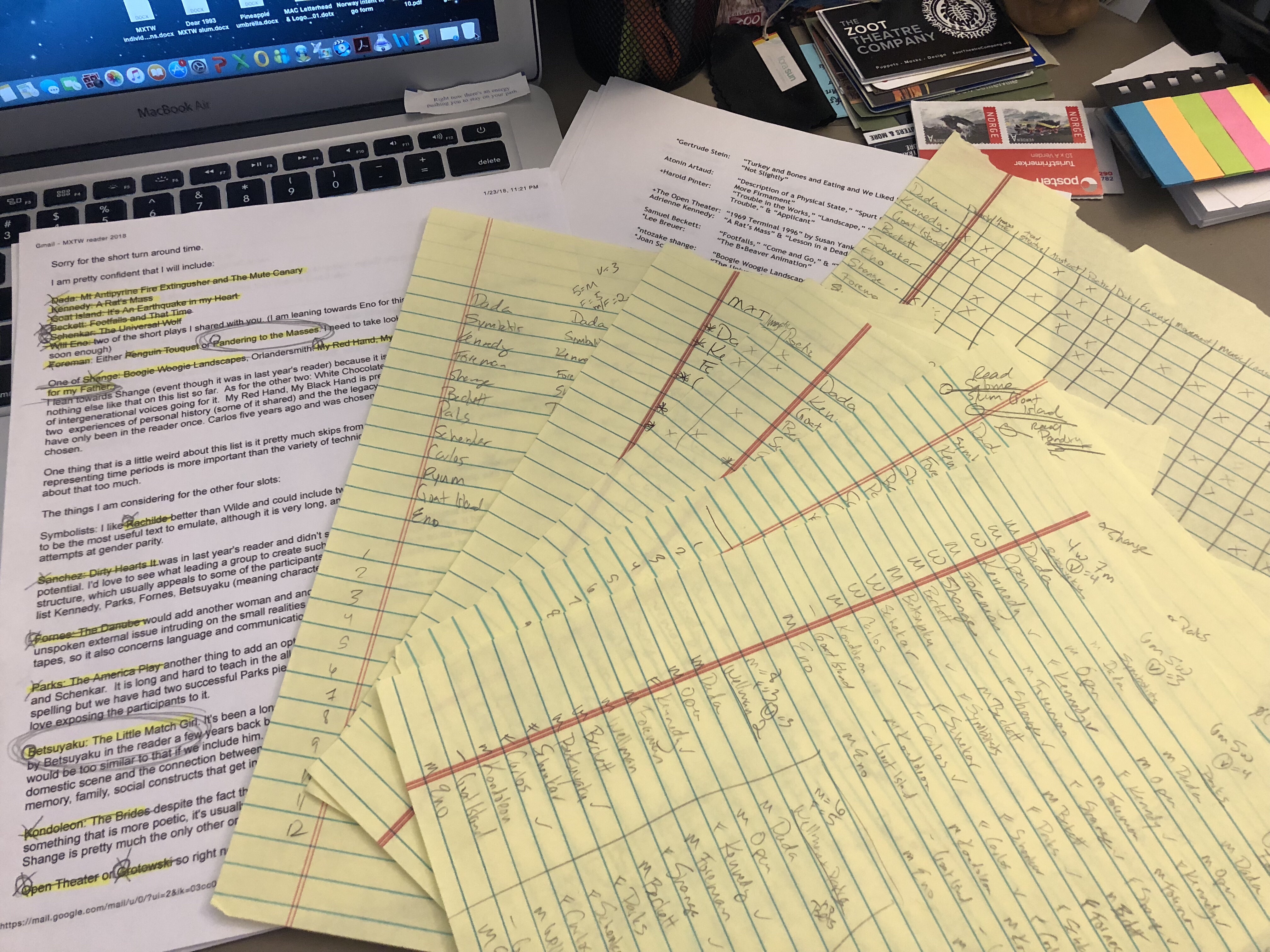The first two weeks of MXTW are spent studying 12 different plays, playwrights, or movements from the history of experimental theatre throughout the past and current century. These plays are collected into what is called the reader. Alums will be familiar with the nature of the reader, while parents, friends, and family might not be aware at all of its existence! Either way, it is probable that not much is known about the process that is behind the reader’s creation. What exactly goes into the reader every year? How is the material chosen?
A lot of loving, careful thought is the answer to both questions.
Every year something new goes into the reader. New meaning: something never studied in the workshop before. Gwethalyn Williams, the director of MXTW, researches plays in order to find someone who uses unique techniques that would work well for MXTW. Gwethalyn gets creative in her searching; asking people for recommendations, bookstore suggestion engines, theatre publications, and even searching the Web for talk of plays that sound like they might make a good fit.
Gwethalyn says it is the researching and reading that is the most challenging and time consuming part of creating the reader. Once the research is complete, the potential new plays must be read in order to determine whether or not it would work well with what MXTW needs. Gwethalyn read about eight or nine new plays for this year’s reader (and skimmed at least a dozen), and found two potential options among that, along with an additional third she had already found previously.
So what exactly makes a play a good selection for the MXTW reader?
According to Gwethalyn, the most important thing is that she is able to identify the techniques the playwright uses, and be able to imagine how to separate those techniques from the subject matter of the play. MXTW tackles a diverse range of ideas and subjects, so the techniques used must be able to lend themselves to a variety of “narratives” (this term is used loosely). For example, Waiting for Godot uses techniques that are so dependent on the subject matter of Godot that, to write another play using the same techniques, would end up being the same play as Waiting for Godot. Easily identifiable techniques that can be applied to new subject matter is criteria number one. If Gwethalyn cannot imagine how she would guide a writing exercise with a play’s given techniques, it is not considered for the reader, no matter how great a play it is.
Once a new addition is figured out, it is time to build the rest of the reader. Twelve plays go into it, meaning there are eleven to be figured out. Care is given to include as much diversity in gender and ethnicity as possible, which is more difficult than it should be given, in Gwethalyn’s well stated words, “the long patriarchal western white culture of theater academia”. Most importantly; however, is diversity in techniques. Some aspects Gwethalyn considers are: an internal vs external focus, is it imagistic, comedic, dark, driven by performers’ choices, poetic, of a more traditional structure (characters that speak in conversations), rhythmic, music, language driven, or movement driven. As you just read, there is a lot to consider! The length of the play also plays (is that a pun?) a part in the selection process; if too many plays are too long, the reader will be too big!
What was included in the last year’s reader must also be considered. Gwethalyn never includes something in the reader that had been chosen by a small group the year before. This is to prevent participants from trying to recreate something they saw previously. Some plays are so popular that they have been placed on a three year rotation, because they almost always are chosen by a small group. Shankar, shange, and Foreman are some of these more popular options. Oh, and Breuer. Definitely Breuer. The people really like Breuer.
In case you did not know, Gwethalyn LOVES yellow writing pads. Before the workshop even begins, she uses up at least half of a pad making lists of every possible permutation of the reader. She sends her lists to the confirmed assistant directors, and if there are none yet confirmed, the lists are sent to alumni who have directed in the past to ask for feedback.
Once the list is finalized, the bibliography is sent to Claflin Books and Copies, who have long been our partners in creating the reader. They do the work of gathering the permissions necessary to copy the plays and print them. Some pieces are free while others require royalties. Sometimes royalties for certain plays are too expensive and a new option must be found.
Gwethalyn loves putting together the reader – it’s one of her most favorite things to do every year! Gwethalyn is truly dedicated to MXTW. She first participated in the workshop in 1995. After graduating, she was an assistant director for a couple years. She left, came back, and was an assistant director for a few more years until Jim offered the position of being the director of MXTW in 2004. Without her contributions, MXTW would not be what it is. The team that drives MXTW is phenomenal for sure!
One final word: sehuiyhjkjnt!!!

Leave a Reply
You must be logged in to post a comment.